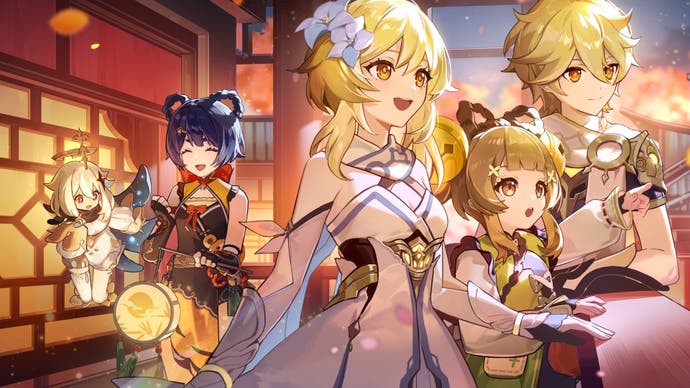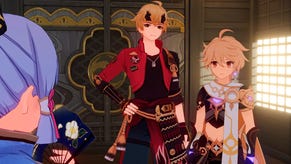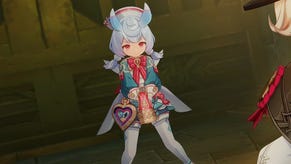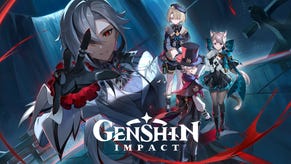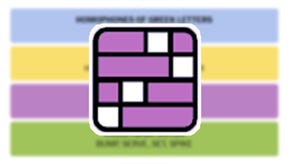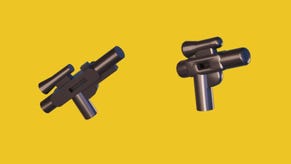Genshin Impact Elemental Reactions chart and guide
Everything you need to know about Elemental Reactions in Genshin Impact.
Creating Elemental Reactions is the core combat mechanic in Genshin Impact.
You can get through most of the story in Genshin Impact by not paying too much attention to how Elemental Reactions work, but if you want to climb those Spiral Abyss floors, you'll need to take advantage of combining the seven Elements.
To help you understand the reactions system, our guide has an Elemental Reactions chart in both picture and table form below, along with detailed breakdowns of how all seven Elements and their reactions work.
While this guide is primarily focused on how your team uses Elemental Reactions on enemies, the same logic mostly applies if enemies apply an Element to you.
On this page:
- Genshin Impact Elemental Reactions chart
- Elements explained (with charts)
- Elemental Reactions explained
- Transformative Reactions explained
- Amplifying Reactions explained
- Additive Reactions explained
- Elemental Absorption explained
- Best Elemental Reactions
- Glossary of Genshin Impact terms
Chart:
Explainers:
Glossary:
Be sure to check out our beginner's guide with tips and tricks, and Genshin Impact codes page to get free Primogems that can be used towards unlocking more characters for your Elemental Reactions.
Genshin Impact Elemental Reactions chart
For quick reference, here's a chart showing how to create all Elemental Reactions in Genshin Impact:

There are individual Elemental Reaction charts in the next section, below the table.
If you'd like to see it in written form instead, here's a table of all Elemental Reactions in Genshin Impact:
| Hydro | Electro | Cryo | Pyro | Anemo | Geo | Dendro | Bloom | Quicken | Frozen | |
|---|---|---|---|---|---|---|---|---|---|---|
| Hydro | Electro-Charged | Frozen | Vaporize | Swirl | Crystallize | Bloom | - | Bloom | ||
| Electro | Electro-Charged | - | Super-Conduct | Overloaded | Swirl | Crystallize | Quicken | Hyperbloom | Aggravate | Super-Conduct |
| Cryo | Frozen | Super-Conduct | - | Melt | Swirl | Crystallize | - | - | - | - |
| Pyro | Vaporize | Overloaded | Melt | - | Swirl | Crystallize | Burning | Burgeon | Burning | Melt |
| Anemo | Swirl | Swirl | Swirl | Swirl | - | - | - | - | - | Swirl |
| Geo | Crystallize | Crystallize | Crystallize | Crystallize | - | - | - | - | Spread | - |
| Dendro | Bloom | Quicken | - | Burning | - | - | - | - | - | - |
| Bloom | - | Hyperbloom | - | Burgeon | - | - | - | - | - | - |
| Quicken | Bloom | Aggravate | - | Burning | - | - | Spread | - | - | - |
| Frozen | - | Super-Conduct | - | Melt | Swirl (on Freeze) | Shatter | - | - | - | - |
Genshin Impact Elements explained
Here's more details on how each of the seven Elements and their Elemental Reactions work in Genshin Impact:
Hydro

Hydro is one of the most versatile Elements in Genshin Impact and arguably its most important, as Hydro application is required to create most of the high-damage reactions and teams, and some of the easiest teams to play also require one or two Hydro characters.
Hydro applies the 'Wet' status when it comes into contact with enemies, which doesn't cause damage itself, but when a Wet aura is on an enemy you can apply another Element to create an Elemental Reaction - and that's what causes damage. Or, you can apply Wet to an enemy that already has an Element on it to create a Hydro reaction instead.
When two Hydro characters are on your team the 'Soothing Water' Elemental Resonance is activated, which means your party is affected by Pyro for 40% less time, and their max HP is increased by 25%.
Electro

Electro is another useful Element that got a huge buff when Dendro was introduced in version 3.0, as it's needed to make Hyperbloom, one of the easiest and effective Elemental Reactions in Genshin Impact as long as you have a good healer or shielder on your team. Other Dendro reactions with Electro like Quicken, Aggravate, and Spread are also highly recommended for easy-to-use teams.
The Electro status on enemies doesn't cause damage itself, but when an Electro aura is on an enemy you can apply another Element to create an Elemental Reaction - and that's what causes damage. Or, you can apply Electro to an enemy that already has an Element on it to create a reaction instead.
When two Electro characters are on your team the 'High Voltage' Elemental Resonance is activated, which means your party is affected by Hydro for 40% less time, and Super-Conduct, Overloaded, Electro-Charged, Quicken, Aggravate, and Hyperbloom reactions have a 100% chance to generate an Electro Elemental Particle, with a cooldown of five seconds.
Dendro
The Dendro Element was properly introduced to Genshin Impact during its version 3.0 update, alongside the Sumeru region, and it's become one of the best and easiest Elements to use for your reactions.
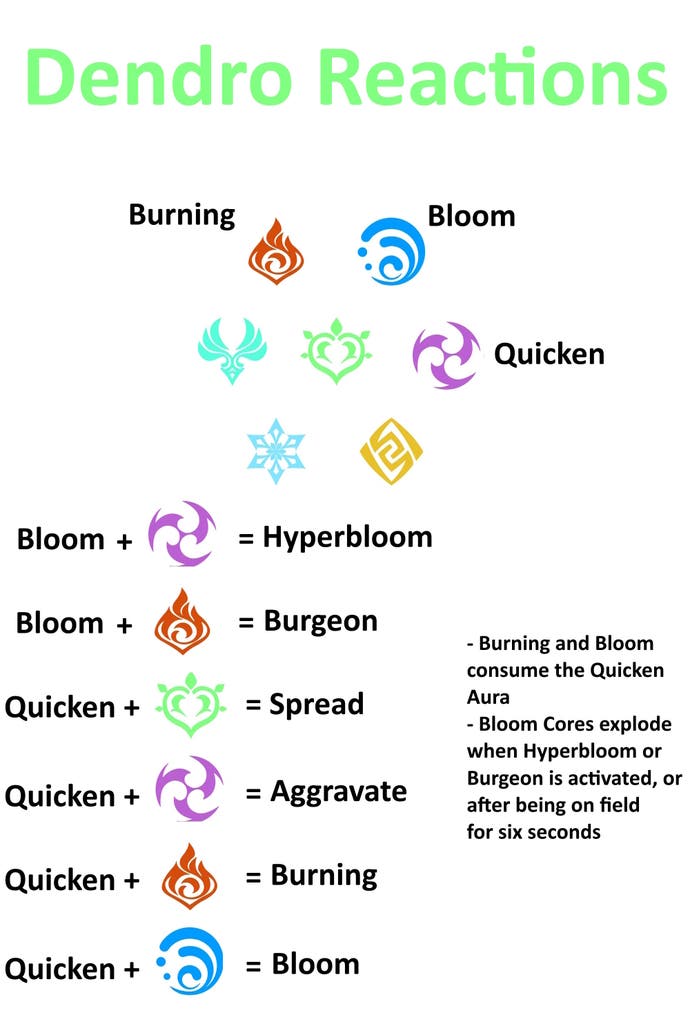
The Dendro status on enemies doesn't cause damage itself, but when a Dendro aura is on an enemy you can apply another Element to create Elemental Reactions - and that's what causes damage. Or, you can apply Dendro to an enemy that already has an Element on it to create a reaction instead.
Although easy to use once you get the hang of it, Dendro can seem a little complicated at first, as it has reactions that occur from its reactions. For example, if you apply Hydro to Dendro or Dendro to Hydro to make the Bloom reaction, Dendro Cores are created. Then, you can create the Hyperbloom or Burgeon reactions if you apply Electro or Pyro to the Dendro cores, respectively. Not applying another element means the Dendro cores explode after six seconds instead.
It's recommended to bring a healer or shielder along in your Bloom adjacent teams to protect you from the Dendro Core explosions.
Additionally, if you create the Burning or Bloom reactions from a Quicken reaction, they consume the Quicken aura to accommodate for these new reactions.
When two Dendro characters are on your team the 'Sprawling Greenery' Elemental Resonance is activated, which means your team's Elemental Mastery is increased by 50, and after triggering Burning, Quicken, or Bloom reactions, all nearby party members gain 30 Elemental Mastery for six seconds. Additionally, after triggering Aggravate, Spread, Hyperbloom, or Burgeon reactions, all nearby party members gain 20 Elemental Mastery for six seconds. The durations of these EM effects are counted independently.
Cryo
While Cryo is a little on the weaker side when comparing how its damage numbers stack up across all of its Elemental Reactions, it has benefits past its reactions, and even with its slightly lower DPS potential Cryo holds its own against tough enemies in Spiral Abyss combat - it just requires a bit more work.

Unlike most other Elements, the Cryo status does have an effect when applied to enemies, as it reduces the animation speed of enemies by 15%. This can stack with other debuffs like those that reduce attack speed, for example.
Frozen and Freeze are very similar to Cryo, but are actually considered separate statuses. Unlike Cryo, neither can react to Hydro, and they don't apply the animation speed reduction, and Freeze is a continuous status that completely stops an enemy's animations.
Freeze is the reaction you'll see a lot if you're using Hydro alongside it, and it can be useful if you want to stop enemies from attacking you while getting some "free" hits in, and to Shatter the enemy for some extra damage.
When two Cryo characters are on your team the 'Shattering Ice' Elemental Resonance is activated, which means your team is affected by Electro for 40% less time, and their Crit Rate is increased by 15% against enemies that are Frozen or affected by Cryo.
Pyro
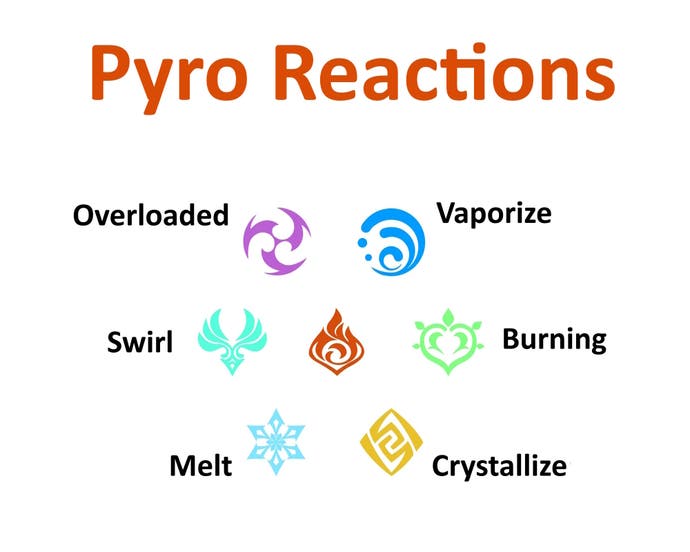
Pyro is still one the best Elements to use in large part because Vaporize is an incredible Elemental Reaction that can see you through a lot of content in the Spiral Abyss if you build your team correctly. It's the weakest Element that reacts to Dendro, but Burning and Burgeon are still very easy reactions to make that can help in situations where Hyperbloom or Catalyze reactions can't.
The Pyro status on enemies doesn't cause damage itself, but when a Pyro aura is on an enemy you can apply another Element to create an Elemental Reaction - and that's what causes damage. Or, you can apply Pyro to an enemy that already has an Element on it to create a reaction instead.
When two Pyro characters are on your team the 'Fervent Flames' Elemental Resonance is activated, which means your team is affected by Cryo for 40% less time, and their Attack stat is increased by 25%.
Anemo

Anemo is a very unique and incredibly useful Element to have on your teams because of the way Swirl works, which can give you more damage by applying the Elements already on enemies to other targets in a set AOE (area of effect). Anemo can also absorb other Elements to cause damage in a slightly different way (for more details on this, go to the 'Elemental Absorption' section below).
Anemo is applied after another Element is applied on an enemy in order to trigger the Swirl reaction. This deals Elemental Damage of the non-Anemo Element in the Swirl reaction, and applies the non-Anemo Element to any any caught in the Swirl's AOE.
Anemo characters usually have some sort of crowd control ability as well, which means you can group enemies closer together and take advantage of applying your Talents and Elemental Reactions to as many enemies as possible, speeding up Spiral Abyss clear times.
When two Anemo characters are on your team the 'Impetuous Winds' Elemental Resonance is activated, which means your team decreases its stamina consumption by 15%, increases their movement speed by 10%, and shortens their Skill cooldown by 5%.
Geo
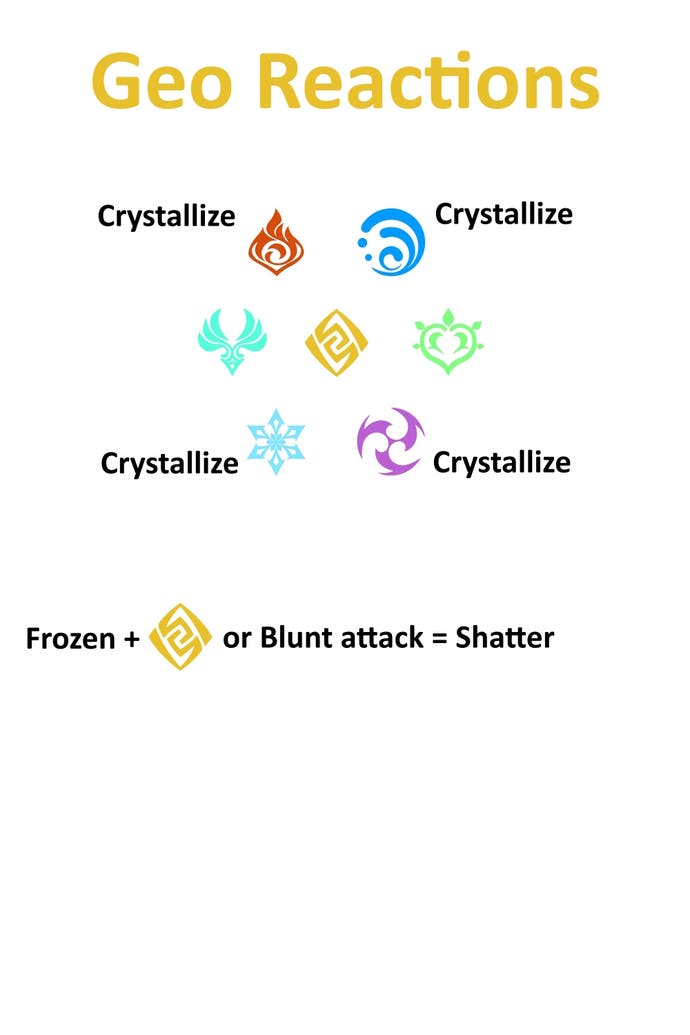
Geo is an easy Element to understand, but hard to build a variety of teams around because of its limitations. Its Crystallize reaction is more about providing shields to your team, not enhancing the DPS of Elemental Reactions.
In short, if you need extra protection for your teams, bringing a Geo character along can help as Geo creates the Crystallize reaction when reacting with Electro, Pyro, Hydro or Cryo. Crystallize then creates a shard of the non-Geo Element, and picking this shard up creates a shield of the non-Geo Element around the character.
Running multiple Geo characters to apply the 'Enduring Rock' Elemental Resonance buff is often utilised, as when two Geo characters are on your team shield strength is increased by 15%, and characters protected by a shield increase their damage dealt by 15%, and dealing damage to enemies also decreases their Geo Resistance by 20% for 15 seconds.
Genshin Impact Elemental Reactions explained
For quick reference, here's a brief summary explaining what every Elemental Reaction does in Genshin Impact:
- Super-Conduct - Deals Area of Effect (AOE) Cryo damage in a 5m radius and reduces the Physical Resistance of all enemies in the AOE by 40% for 12 seconds. Does not apply Cryo to targets hit, so can't trigger further Elemental Reactions.
- Electro-Charged - Deals Electro damage over time to both the Electro-Charged enemy and any nearby targets that have the Wet aura. It can't damage off-field characters, and swapping to another character after being Electro-Charged temporarily pauses its Damage Over Time (DOT). However, if the Electro-Charged character becomes the active character again while still affected by both Electro and Hydro, the DOT will resume.
- Frozen - Deals no damage, but applies a Freeze aura for a period of time that immobilises enemies.
- Shatter - Occurs when a Blunt or Geo attack meets a Frozen target, and this deals Physical damage and removes the Freeze aura.
- Vaporize - Increases the damage of the Hydro or Pyro attack that triggers the reaction. If the reaction is triggered by a Pyro attack, the damage is multiplied by 1.5, and if the reaction is triggered by a Hydro attack, the damage is multiplied by two. The lower the multiplication, the slower the first element (aura) is consumed. Using Pyro, Electro, Anemo, or inflicting Freeze consumes Vaporize to trigger Melt, Superconduct, or Swirl, respectively.
- Swirl - Deals Elemental damage of the non-Anemo element involved and applies the non-Anemo Element to enemies within a 6m radius. Swirl damage is not the same as Elemental Absorption. See below for more details on what Elemental Absorption is.
- Crystallize - Crystallize creates a shard of the non-Geo Element when reacting with Electro, Pyro, Hydro or Cryo. When this shard is picked up, it creates a shield of the non-Geo Element around the active character.
- Overloaded - Creates an explosion that deals AOE Pyro damage in a 5m radius, which creates a significant knockback effect. Overload is also a Blunt Attack, so can trigger Shatter. Overload is more effective at damaging certain enemy shields, but it does not apply Pyro to enemies, so can't trigger further Elemental Reactions.
- Melt - Increases the damage of the Pyro or Cryo attack that triggers the reaction. If the reaction is triggered by a Cryo attack, the damage is multiplied by 1.5, and if the reaction is triggered by a Pyro attack, the damage is multiplied by two. The lower the multiplication, the slower the first element (aura) is consumed.
- Burning - Deals AOE Pyro damage and applies Pyro in a 1m radius to enemies and your active character. This Pyro application has an internal cooldown of two seconds. The Burning aura is active at the same time as the underlying Pyro and Dendro auras. Burning requires both the Burning and Dendro auras to be active, so will end if one of them is depleted.
- Bloom - Produces a Dendro Core that stays on the field for up to six seconds, and has different effects based on if Pyro, Electro or neither is applied to it before its duration expires. Only five Dendro Cores can exist at once, so creating more than five Dendro Cores causes the oldest one to immediately explode.
- Burgeon - Burgeon damage is calculated from the Character Level and Elemental Mastery stat of the one who triggers the Burgeon reaction, along with the enemies' Resistance stat. Burgeon ignores the target's Defense stat, but can't Crit.
- Hyperbloom - Transforms a Dendro Core into a Sprawling Shot that homes in on the closest enemy, dealing increased AOE Dendro damage in a 1m radius to both enemies and your team.
- Spread - When Dendro is applied to enemies with the Quicken Aura, Spread is triggered, which grants the attack a flat damage bonus. Spread doesn't consume the Quicken Aura.
- Aggravate - When Electro is applied to enemies with the Quicken Aura, Aggravate is triggered, which grants the attack a flat damage bonus. Aggravate doesn't consume the Quicken Aura.

Genshin Impact Transformative Reactions explained
Transformative Reactions deal their own instances of damage, separate from the attacks triggering them. Transformative Reactions only scale off the base damage and Elemental Mastery of the character triggering the reaction, so a character's Crit Damage and attack stat have no effect on Transformative Reaction damage.
Additionally, Transformative Reaction damage ignores an enemy's Defence, but is still affected by their specific Elemental or Physical Resistance.
There are nine Transformative Reactions currently in Genshin Impact:
- Bloom
- Burgeon
- Burning
- Electro-Charged
- Hyperbloom
- Overloaded
- Shattered
- Super-Conduct
- Swirl
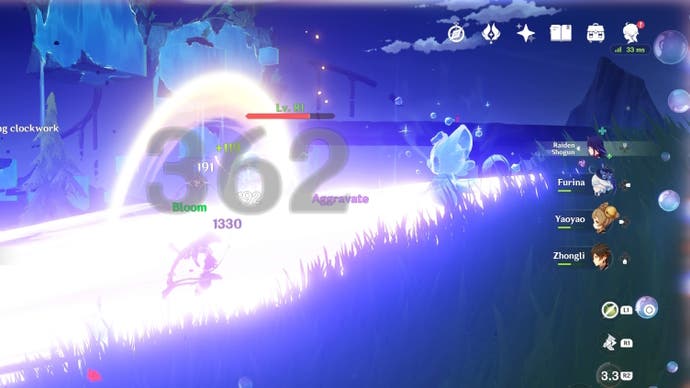
Genshin Impact Amplifying Reactions explained
Amplifying Reactions don't deal their own instances of damage, as they instead multiply the damage of the attacks that trigger them by either x2 or x1.5 depending on what Element triggered the reaction. The x2 reaction is often called Forward, and the x1.5 reaction is often called Reverse. For example, using Pyro on Hydro causes a Reverse Vaporize reaction, meaning the damage from the Pyro character is multiplied by 1.5. If Hydro was applied to Pyro instead, the multiplier would be x2 as part of a Forward Vaporize reaction.
The damage of Amplifying Reactions is then multiplied again by an amount determined by how much Elemental Mastery a character has.
It's not always beneficial to use Forward reactions even if it seems it causes more damage, as Reverse reactions don't consume an Elemental aura on an enemy as quickly, meaning you can fit in more Elemental Reaction attacks before it goes away.
There are two Transformative Reactions currently in Genshin Impact:
- Melt
- Vaporize

Genshin Impact Additive Reactions explained
Like Amplifying Reactions, Additive Reactions also increase the damage of the specific hit that triggers the Additive Reaction without dealing damage of its own, but Additive Reactions provide a base damage bonus added onto the calculated base damage instead of multiplying.
There are two Additive Reactions currently in Genshin Impact:
- Aggravate
- Spread

Genshin Impact Elemental Absorption explained
Elemental Absorption is an effect most Anemo characters have access to that allows them to absorb either Pyro, Hydro, Electro, or Cryo on its first contact, and become infused with that Element. This deals damage of the Element they absorbed and Anemo damage, or provides other effects based on the Element absorbed.
Unlike Swirl, Elemental Absorption is considered regular damage, so it is affected by a character's attack, Crit Damage, and damage bonus stats.
If there is more than one Element that can be absorbed, generally, only one will be. The priority order for the absorption is:
- Pyro
- Hydro
- Electro
- Cryo
However, for the Anemo Traveler and Lynette, the priority order for the absorption is:
- Cryo
- Pyro
- Hydro
- Electro
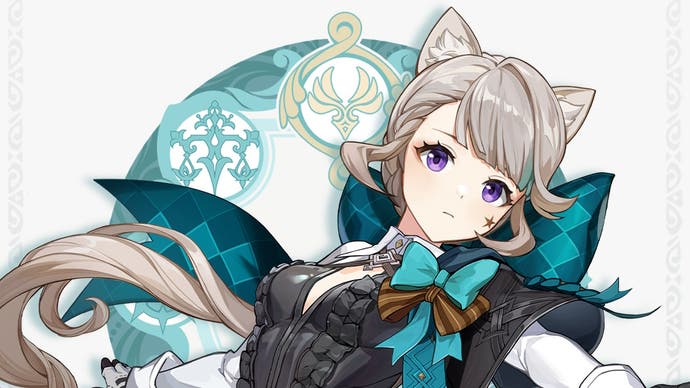
Best Elemental Reactions in Genshin Impact
While all Elemental Reactions are useful while taking on the Spiral Abyss, some are generally more effective than others due to their ease of use, variety of teams that can produce them, or the ways in which they enhance other Elemental Reactions.
With this in mind, there are three reactions that we consider the best Elemental Reactions in Genshin Impact:
- Hyperbloom
- Swirl
- Vape
Here's more details on why we rate these reactions so highly:
Hyperbloom
Hyperbloom is such a brilliant Elemental Reaction to build your teams around because it's so easy to get characters that work with it, and its damage can see you through so much of the Spiral Abyss, regardless of what enemies they throw at you. Free-to-play teams that have characters like the Dendro Traveler, Barbara and Lisa are viable, but Hyperbloom gets even better when you start to swap out your 4-Stars for 5-Stars like Nahida and Kokomi.
The only big downsides to Hyperbloom are that it's not really suited to single-target encounters, and that you have to run either a healer or a shielder in your teams, as you'll be taking constant damage from the exploding Dendro Cores.

Swirl
Combined with the Elemental Absorption capabilities on Anemo characters, it's clear to see why so many of the top teams use characters like Kazuha or Sucrose in their final slot. Creating continuous Swirls of Elements already applied to enemies onto even more enemies is a very quick and efficient way to get even more DPS out of your teams.
There aren't a whole lot of downsides to aiming for Swirl reactions, but bringing an Anemo character along for your final slot can actually be a bad thing for teams that require specific Elements or character abilities to work, and unfortunately, Anemo doesn't really work with Dendro reactions (but that hasn't stopped the creation of fun teams like Soup and Salad - more information on these party comps in the glossary section below).
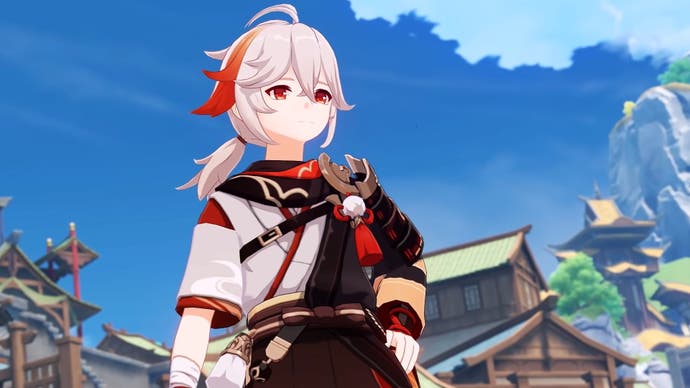
Vaporize
The reason Vaporize is such a good Elemental Reaction is because it can work incredibly well (and sometimes best) with just 4-Star characters. Unless the enemy has some sort of resistance or shield against your reaction, most Vaporize teams can see you through a lot of tough encounters in the Spiral Abyss.
The damage of Vaporize isn't ridiculously overpowered when compared to other 'normal' reactions like Super-Counduct or Melt, it's more so that Vaporize is a very powerful Elemental Reaction that is easy to create and build your teams around - especially if you include Xiangling.

Glossary of Genshin Impact terms
There are some names for Elemental Reactions and specific combat mechanics and teams that the online community around Genshin Impact uses more often than official terminology, and some names that don't have an official term, so the community created them.
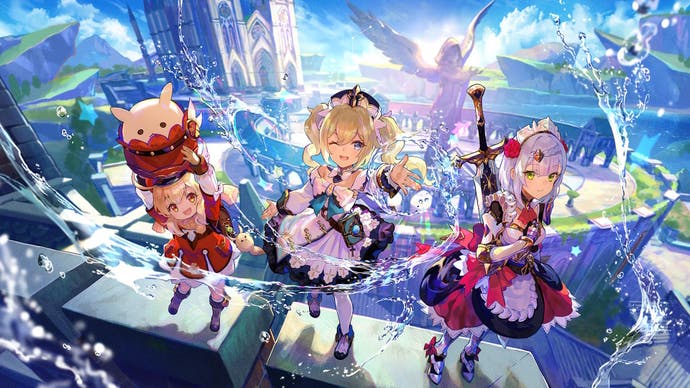
To help you understand what more Elemental Reactions, teams, and combat mechanics mean, here's a glossary of Genshin Impact terms:
- Battery - A team member who generates Energy for other characters.
- Driver - A team member used primarily on-field to consistently trigger other characters' off-field abilities and Elements. Drivers often have consistent application of their Element, and fast animations.
- Enabler - A character that usually helps other characters or your whole team do more damage, typically by applying an Element on enemies for others to use their Element on and create Elemental Reactions.
- Forward Melt - Applying Pyro to Cryo for a x2 damage multiplier.
- Forward Vape - Applying Hydro to Pyro for a x2 damage multiplier.
- Fridge - Applying Hydro to an enemy with both Cryo and Dendro applied. This means Frozen is triggered first, which consumes the majority of the Hydro applied. Then, Bloom is triggered and Dendro application is slowly reduced, allowing for more Bloom cores to be created.
- Hypercarry - A team member that has a very high damage output when compared to other characters.
- International - Also referred to as Childe National, International means your team is made up of Childe, Xingqiu, Bennett, and Kazuha.
- Microwave - Using Zhongli's skill to create a Stone Stele and the Geo Traveler's constructs to increase the range and the amount of pulses of Zhongli's Stone Stele. Zhongli is played off-field in this team.
- Mono - A team of three or four characters who have the same Element. For example, a team of Zhongli, Gorou, the Geo Traveler, and Furina is still considered a Mono Geo team.
- Motion Value - The percentage of a character's stats dealt using an attack. Checking it can help determine a character's DPS (damage per second) output.
- National - Your team is made up of Xiangling, Xingqiu, Bennett, and a fourth character who usually names the team. For example a team of Sucrose, Xiangling, Xingqiu, and Bennett is called Sucrose National. Xingqiu is sometimes replaced with Yelan, Ayato, Childe, or another Hydro character.
- Overvape - A combination of the Overloaded and Vaporize Elemental Reactions. Overvape happens when Pyro is applied to enemies with the Electro-Charged reaction already applied (When Hydro meets Electro, or Electro meets Hydro).
- Quickbloom - A combination of the Hyperbloom and Quicken Elemental Reactions. Quickbloom happens when both the Quicken reaction (Electro on Dendro, or Dendro on Electro) and Hyperbloom reaction (Electro on Bloom) make up your team's damage consistently. This happens when Hydro or Dendro application is slow.
- Rational - The regular National team (Xiangling, Xingqiu, Bennett) with Raiden Shogun.
- Resistance Shred - Occurs when you decrease the Elemental Resistance or Physical Resistance of enemies. This allows you to up the DPS of your teams that might struggle otherwise.
- Reverse Melt - Applying Cryo to Pyro for a x1.5 damage multiplier.
- Reverse Vape - Applying Pyro to Hydro for a x1.5 damage multiplier.
- Salad - A Hyperbloom team made up of Anemo, Dendro, Electro, and Hydro characters where you use the Anemo character to trigger Hyperbloom by using Elemental Absorption or the Swirl reaction, which lets the Electro DPS character be built around Quicken, Aggravate, or Spread.
- Soup - A team made up of Hydro, Electro, Pyro, and Anemo characters so you can trigger the Electro-Charged, Vaporize, Overloaded, and Swirl reactions.
- Stat Stick - A weapon you equip on a character for its stats alone, not its bonus abilities. Often used for characters who scale off a specific stat and need as much of it as possible. For example, a character whose attack actually scales off how much HP they have could equip a weapon with a HP main stat to increase their DPS.
- Sunfire - Refers to when Jean and Bennett's Elemental Bursts are both active, which constantly Swirls Pyro from the on-field character and applies it to enemies.
- Taser - Another name for the Electro-Charged Elemental Reaction (Electro on Hydro, or Hydro on Electro).
- Trigger - The second element applied in an Elemental Reaction. For example, Electro would be the trigger for the Electro-Charged reaction if Hydro was already applied to an enemy.
- Vape - Short for the Vaporize Elemental Reaction (Pyro on Hydro or Hydro on Pyro).
- Catalyze - The group of Elemental Reactions that come from Dendro and Electro: Quicken, Aggravate, and Spread.
- DPS - Damage per second.
- AOE - Area of Effect.
For more explainers, check out our beginner's guide, and how the Pity, Soft Pity, 50/50 and Epitomized Path systems work.
